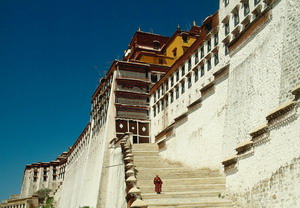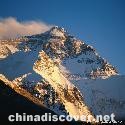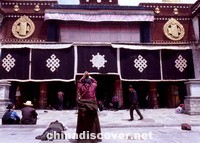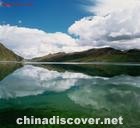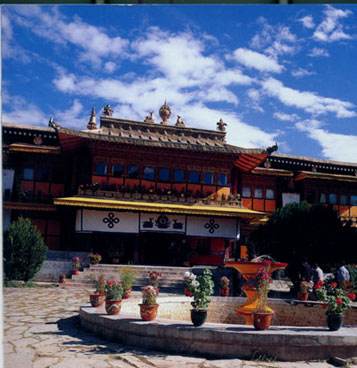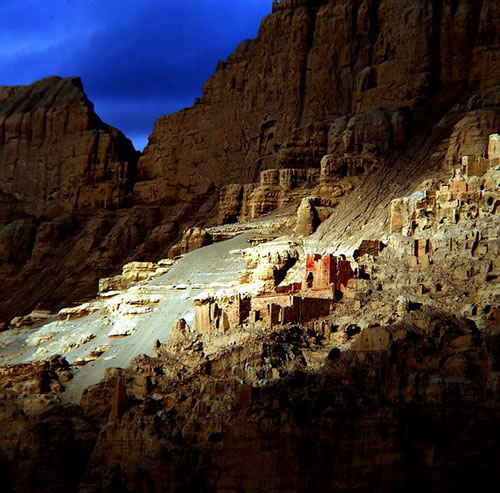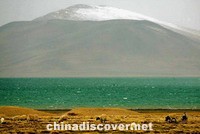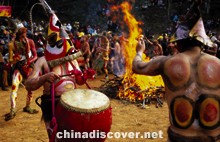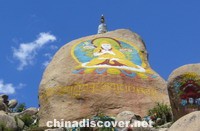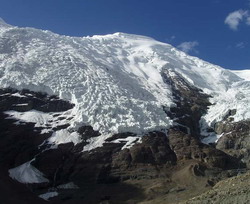Mt. Kailas

Overview
Throughout Asia exist stories of a great mountain, the navel of the world, from which flow four great rivers that give life to the areas they pass through, this is the Mt. Kailas, which is the key to the drainage system of the Tibetan plateau. Four of the great rivers of the Indian subcontinent originate here: the Karnali, which feeds in to Ganges (south); the Indus (north); the Sutlej (west); and the Brahmaputra (Yarlung Tsangpo, east).
Mt. Kailash, at 6714m, is not the mightiest of the mountains in the region, but with its hulking shape-like the handle of a millstone, according to Tibetans-and its year-long snow-capped peak, it stands apart from the pack. Its four sheer walls match the cardinal points of the compass, and its southern face is famously marked by a long vertical cleft punctuated halfway down its traverse by a horizontal line of rock strata. This scarring resemles a swastika-a Buddhist symbol of spiritual strength- and is a feature that has contributed to Kailash's mythical status. The mountains is known in Tibetan as Kang Rinpoche, or ' Precious Jewel of Snow '.
Know more
Story of Mt. Kailash
Mt. Kailash has long been an object of worship for four major religions. For the Hindus, it is the domain of Shiva, the Destroyer and Transformer. To the Buddhist faithful, Mt. Kailash is the abode of Demchok (Sanskrit: Samvara), a wrathful manifestation of Sakyamuni ( Sakya Thukpa) thought to be the equivalent of Hinduism's Shiva. The Jains of India also revere the mountian as the site at which the first of their saints was emancipated. And in the ancient Bon religion of Tibet, Kailash was the sacred Yungdrung Gutseg (Nine-Stacked-Swastika Mountain) upon which the Bonpo founder Shenrab alighted from heaven.
Mt. Kailash has been a lodestone to pilgrims and adventurous travellers for centuries, but until recently, very few had set their eyes on the sacred mountain. This situation has begun to change in recent years. In May 2001 Spanish climbers even gained permission to climb the peak, only to abandon their attempt in the face of international protests.
Mt. Kailash, The Trek at a Glance
The 52km circuit or kora of Mt. Kailash is one of the most important pilgrimages in Asia. A religious sanctuary since pre-Buddhist times, a trek here wonderfully integrates the spiritual, cultural and physical dimensions of a trip to Tibet, which explains its growing attention. The well-trodden track around the sacred mountain passes through verdant alpine valleys linked by a lofty pass, the Drolma-la. Being able to meet pilgrims from across Tibet and other countries is one of the many allures of this walk.
Trekking season of Mt. Kailash uns from mid-May to mid-October, but trekkers should be prepared for changeable weather at any time. See the Nagri (Western Tibet) chapter for an introduction to Mt. Kailash and the kora. as well as for further information on Darchen, the shabby little town where the walk starts and finishes. Snow may be encountered on the Drolma-la at any time of year and the temperature will often drop below freezing at night. The pass tends to be snowed in from early November to early Aril.
Must see
Lake Manasarovar
Lake Manasarovar (Mapham yum-tso; 4,556m), or Mapham Yum-tso (Victorious Lake) in Tibetan, is the the most venerated of Tibet's many lakes. According to ancient Hindu and Buddhist cosmology the four great rivers of the Indian su-continent, the Indus, Ganges, Sutlej and Brahmaputra, arise from Manasarovar. In reality, only the Sutlej River originates at the lake, although the headwaters of the other great rivers are in close proximity. Just 20km from Mt Kailash across the Barkha plain, Manasarovar can be circumambulated in four or five days. Five of the original eight monasteries in the area have been partially rebuilt...more
Chiu Monastery
33km south of Darchen and 8km south of the main highway, Chiu Monastery enjoys a fabulous location atop a craggy hill overlooking the sapphire blue Lake Manasarovar. The chape here contains images of Sakyamuni (Sakya Thukpa) and Guru Rinpoche. Climb up to the roof of the monastery for stunning views of the lake. The huge peak on the southern horizon is 7,728m Gurla Mandata, near the border with Nepal.
There are hot springs behind the monastery, and a small glass-roofed bathhouse close to the village. The water is channelled from the hot springs into individual cubicles via open ducts and it's barely likewarm by the time you can get a few centimetres of water into the mouldy tiled tubs. You can also do your laundry in the warm outflow around the back...more
Guge Kingdom
Tholing and neighbouring Tsaparang are the ruined former capitals of the ancient Guge kingdom of Nagri, accessed via the modern Chinese town of Zanda (also known as Thsasda or Zhada). Tsaparang, in particular, is a truly amazing sight, in part because it is so little known. The 9th-century ruins are carved into the steep sides of an imposing ridge. Cave dwellings, stunning monastic buildings and a ruined palace are linked by twisting paths and secret tunnels that worm their way into the rock itself.
This barren landscape seems an unlikely place for a major civilisation to have developed; yet the Guge Kingdom thrived as an important stop on the trade route between India and Tibet. By the 10th century it was a wealthy centre supporting several thousand people, and the great Guge King Yeshe O began to nurture an exdhange of ideas between India and Tibet. Yeshe O sent the young monk Rinchen Zangpo to study in India; the monk returned 17 years later to become one of Tibet's greatest translators of Sanskrit texts, and a key figure in the revival of Buddhism across the Tibetan plateau ...more
